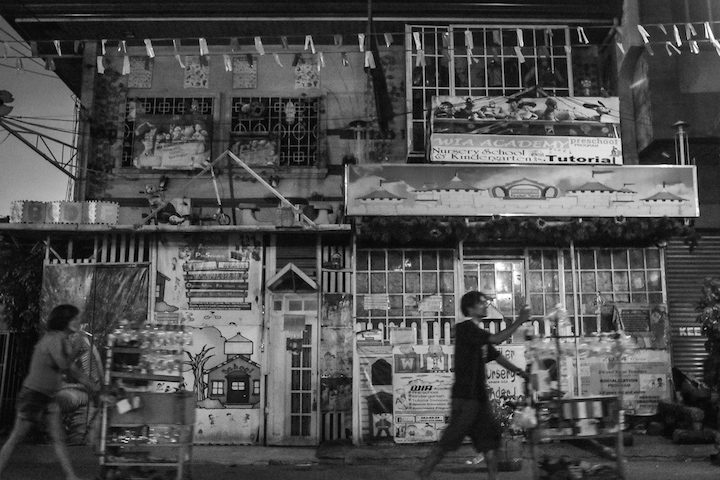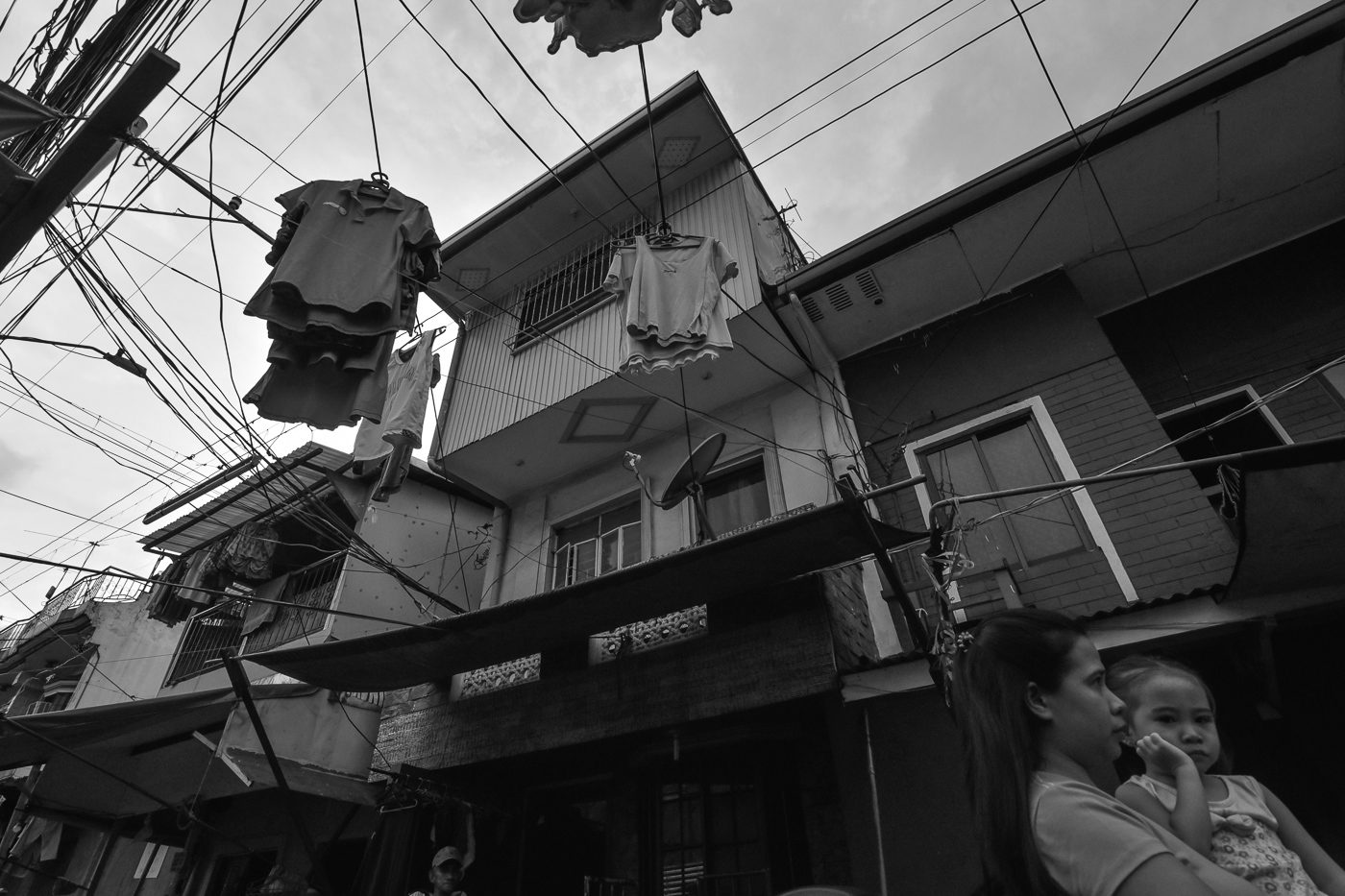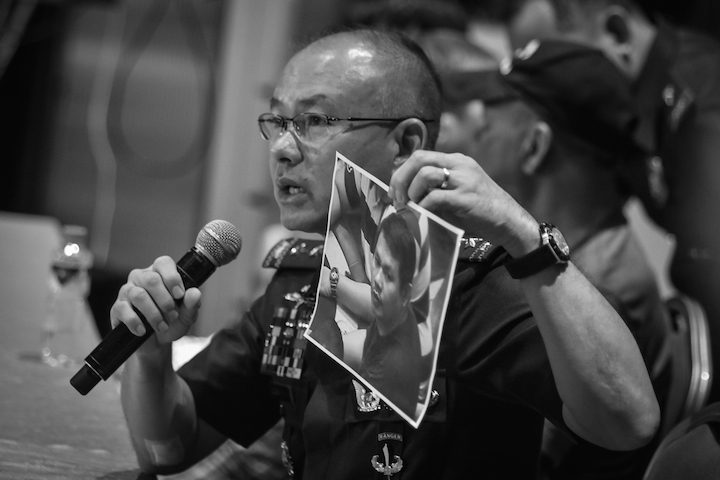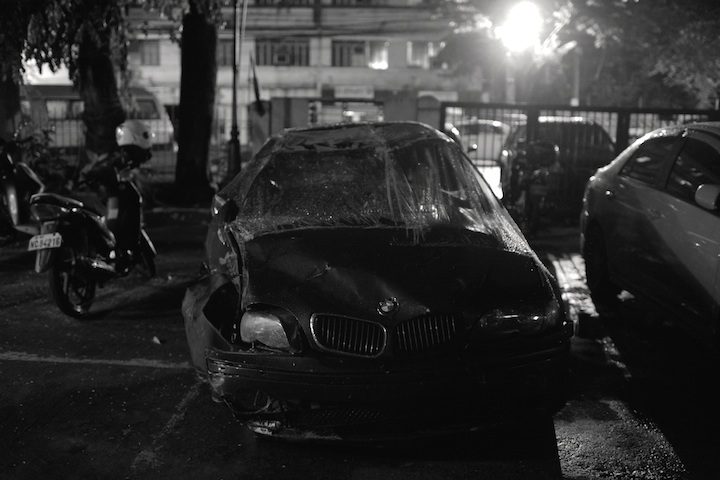SUMMARY
This is AI generated summarization, which may have errors. For context, always refer to the full article.

This compilation was migrated from our archives
Visit the archived version to read the full article.
The gunman did not run. He strolled past the pink tables of the Tao Yuan Restaurant at 11 minutes past midnight of Friday, June 2. He was a tall man, big and broad. Some say he was 6 feet tall, others say a little less. There was a mask over his face and an ammunition vest slung over his shoulders. He walked by a metal detector carrying a Bushmaster M4 carbine, a .380-millimeter revolver, and a backpack with the bottles of gasoline he bought off the Sea Oil station across his house.
There were 12,142 souls inside Resorts World Manila that night, scattered under the unblinking eyes of 3,000 cameras, whose feeds beamed straight into the 11 consoles sitting at the 2nd floor CCTV room. There were 52 internal security men who manned the casinos, while another security team patrolled the perimeter, armed with 6 AK-47s, two M4 rifles and a pair of shotguns.
The gunman ignored the security guard who gave chase. He walked all the way to the Prosperity Lounge without breaking his stride, and shot into the air as patrons went running. There was a rhythm to his movements: backpack, bottle, gasoline, lighter, fire, over and over, in room after room. Gunfire exploded from the 300-round bandolier of ammunition he left at a casino table. Slot machines and padded chairs erupted into flames.
He did not run when he shot the locks off the door of the chip bank and took out a stack of chips, one, two, 13 times, tucking them all into his bag before fastening the flap over the opening. He did not run when the security men shot him in a stairwell, or when he limped up to the 5th floor of Maxim’s Hotel.
There were many theories put forward in the next two days. The Speaker of the House called the gunman “a lone-wolf terrorist.” International papers called him an “English-speaking gunman.” Terror group ISIS celebrated the number of “Christians killed or wounded” and announced that the attack was carried out by “Islamic State fighters.” The Bureau of Fire Protection said the gunman was “a longtime guest” of the casino’s hotel. Some, including the gunman’s neighbors from Santa Cruz, Manila, thought he was an Abu Sayyaff bandit. The gunman’s own cousin, watching the news from home, thought the man in the mask was “some foreigner” who had managed to find his way in.
There are many places to begin this story, but every beginning ends the same way: inside a hotel room, high above a city, the man on the bed burnt and dead with a bullet in his skull and a rifle on his chest.
THE NEIGHBOR
For the people of Village 339, the story begins along Felix Huertas Street, almost 10 years ago, when Mr and Mrs Jessie Carlos moved into the two-story house at the corner of San Lazaro Street.
The Carloses were pleasant people. Jessie was a big man, tall and “very good-looking.” He was the sort of neighbor who never refused young Nico when he knocked at number 1663 for a donation to help the local basketball team. His wife Jen didn’t socialize much, but she took the trouble to send a Christmas gift – a tumbler, a T-shirt, and a calendar – to the homeless man living on a couch beside their house. It was a village where children popped into each other’s houses and pickup basketball games were played in the summer twilight. It was by no means a quiet place, but it was a safe neighborhood, the houses still maintaining the wooden sidings and iron railings of old Manila. The knife-edge of Tondo might curve around the 4 blocks of Village 339, but its 3,000-strong population of office clerks and businessmen and seamstresses and vendors were involved in nothing more menacing than the occasional horse race betting down an alley.
They were a quiet couple, by and large. Boss Jessie, as the neighbors knew him, might cross the street for a pack of cigarettes, but he wasn’t the sort to sit down on a plastic chair to shoot the breeze over a bottle of beer. He would open the front door, walk to his car, slip his gun under the backseat, and maybe nod his head at whoever called out a greeting.
The Carloses had 3 children – a girl and two boys. They went to private school and had private tutors and a driver named Ben who was always there at 6 in the morning. Sometimes, said Ben, there were birthdays at a resort in Bulacan, or family dinners at the Seaside Restaurant in Baclaran. There was also a rotating series of cars – the Hyundai Starex that was traded for the Mitsubishi L300, the Montero Sport that replaced the red Toyota Innova, just before Jessie came home with his favorite, the Ford Ranger Wildtrak pickup.
Nobody was very sure how Jessie Carlos made his living. The village chairman said Jessie supplied lighting to the public market. The tricycle driver parked across the street said Jessie ran a cock-breeding farm. Some of the neighbors thought he maybe worked for the government, because there was a sticker pasted years ago to the windshield of his car. Jen Carlos set up a pre-school in front of their house, although as far as anyone knew, it serviced only a single student, if at all, in the 3 years since the fading signs were put up.
There had never been many visitors at Number 1663, with the exception of Jessie’s parents, who, more and more in the last few months, turned away after discovering the doorbell received no response. The shiny cars began disappearing. There was word the couple wanted to sell the property. Ben, who had driven the children back and forth to school for 9 years, left in early May and never came back. “They stopped calling me to work every day,” Ben said, “and I needed to make a living.”
It all came to a head on June 3, when the cops came marching in. The street had been blocked off for 3 days for the Feast of the Holy Spirit. Streamers were hung, and everyone with the nerve to try were invited to strut down the makeshift stage in swimming trunks and bikinis. The police began asking the residents questions. They had a folder with pictures of a gunman dressed in black.
The chairman told the police it maybe looked like Boss Jessie – “But I thought no, he wasn’t that sort of person.”
It was only after the news appeared on television the next day that everyone discovered Boss Jessie had a secret.
“He was a nice man,” said his neighbor Susan. “His wife was a bit of a snob, but he was really nice.”



Clockwise(1) Fernando Carlos (second from left), Teodora Carlos, NCRPO Chief Oscar Albayalde, Jen Carlos. (2) The current Carlos home in Tondo. (3) Where Jessie Carlos lived during his childhood. Photos by LeAnne Jazul
THE FAMILY MAN
For Ohna Medina, who was asleep on the 2nd floor of the same Tondo neighborhood where he had lived for 43 years, the story began with a phone call. The call came from a friend – “What happened to your cousin?”
Ohna ran downstairs to the television. He saw his aunt and uncle, Jessie’s parents, sitting in a row behind a yellow-draped table. Jessie’s wife Jen was limp on a wheelchair, a towel covering her face. She did not speak to the press. Jessie’s father begged forgiveness. His mother cried.
“My son is a good boy,” Teodora Carlos said, “he just got addicted to gambling.”
Ohna, at home and watching, stared at the gunman when the CCTV video rolled. It was only when he recognized the cousin he called Bototoy that Ohna, a big, shy man with a hoop hanging off his left ear, began sobbing.
Jessie Carlos grew up one of many cousins. There were so many of them in Tondo that none of them were sure exactly how many. Jessie and Ohna, born months apart, were inseparable. The Carloses were so poor that Teodora had to hawk baked goods on her knees for hours to send the children to school.
Jessie’s family lived in a narrow wooden house along a narrow alley that they rented from Ohna’s family. When Jessie was very young, the family moved to an informal settlement a corner away, and spent the next few years fighting eviction. Jessie worked odd jobs, driving a jeep, restoring furniture, until he went off to the Philippine Marine Institute to study custom brokerage. His cousin Lelani said that though Jessie wasn’t the sort to get medals in school – “He wasn’t smart enough for that” – he was determined to do well. He passed the board exam, and went on to work for a private company before he went into the Department of Finance. Before 200 people, he was married in the Manila Cathedral to his college sweetheart and had his reception in grand fashion at the church basement.
It was soon after that Jessie stepped into his new life, where the money was good and the cars were new and everyone in the neighborhood where he had once grown up believed he had flown high and would fly higher. The boy who grew up playing with soda caps drove into Tondo wearing Lacoste. He bought a house and a lot when his parents were evicted. He paid for rounds of beer for the old friends who sat shirtless in the heat. He sent his mother to the doctor when she was sick. His 3 children were polite and well-dressed, unlike Ohna’s own 3 children who went to public school and were happy to run wild. There were presents every Christmas, along with envelopes lined with a thousand pesos each for every relative who could claim a connection. Ohna, who never went past his 2nd year in high school, was proud of his cousin.
That Jessie was an inveterate gambler wasn’t a secret. His neighbor Cecilia, whose son grew up with Jessie, said Jessie began early, playing kara-krus on the street with the boys. The cockfighting came later. Ohna said he and Jessie would bet together at cockfights, only that Ohna would bet maybe P5,000 on a good day, and Jessie would drop 50 grand. Ohna had heard, through one friend or another, that his cousin had begun gambling in casinos. He had heard Jessie was losing big, but he never asked Jessie.
Ohna is an earnest man, a little shy in spite of his size, and sheepish about the fact he makes a living buying and selling street arcade games. He smiles shrugs, calls himself a survivor. When they sat at the Tanauan farm with their tumblers of gin, Jessie would talk, and Ohna would listen. “He liked to make himself the star of his own story,” laughed Ohna. “Definitely I did the listening, though I did manage to comment once in a while.”
Jessie would hold forth on his various successes. There was mining somewhere in Davao, there was a fishery business somewhere else. There was a farm in Tanauan breeding cocks. There was an employment agency. He had many businesses, he said, and had partners who were big names.
“The truth is,” Ohna said, “I can’t deny I was jealous of my cousin, that he had made it. There’s a big distance between his life and mine.”
Often, during the two years since their last conversation, Ohna would notice that Jessie was missing from family gatherings. There were still Christmas presents, but Jessie himself had stopped coming.
Ohna tried to see his cousin. He dropped by the house in Felix Huertas twice, but was told his cousin wasn’t home. Ohna was too embarrassed to keep asking, so he stopped knocking on the door.
In April, Jessie’s birthday, Ohna decided to try again. “I missed him,” he said simply. He made plans. He asked his wife to prepare gelatin and the roasted fish stuffed with tomatoes that Jessie liked. He tried to ask for Jessie’s number from his family – Ohna had lost his phone – but Jessie’s sibling didn’t have contact. Ohna was told there had been a family disagreement.
Ohna gave up. He never saw his cousin again.

THE DEFENDANT
The story, for the government, began with the money. Jessie Javier Carlos, Filipino, was a 42-year-old former tax specialist who had been dismissed by the Department of Finance for misdeclaring his assets. He was a “high-roller gambler” whose many debts included a P4-million charge in a single bank account. His gambling – his family had him banned from all casinos in March – had led to a separation from his wife, and a “misunderstanding” with his family.
The boy from Tondo was soaring high, and his employers took notice.
In 2011, the Revenue Integrity Protection Service of the Department of Finance filed a complaint against Jessie Carlos for the non-disclosure of his properties, as well as the accumulation of unexplained wealth while “obtaining dubious loans to cover up the gains in his assets.” At the time, Jessie was making a little more than P15,000 a month, but had declared assets of more than P9 million. In 2012, the Office of the Ombudsman found Jessie “unable to reasonably explain the huge disparity” between his income and his properties. He was dismissed in 2014. His retirement benefits were forfeited, and he was disqualified for any post in government service.
On March 6, 2015, the Office of the Ombudsman filed Civil Case 15133167 against Jose Javier Carlos, with his wife as co-respondent. Prosecutors sought the forfeiture of P6,742,244 of unexplained wealth. The charge sheet also said Jessie “made it appear that he has incurred large amount of loans involving millions of pesos,” none of which were proven lawful in the “absence of any document where it can be shown who his creditors were.”
In January of 2016, Jessie attempted to settle the case for P1.2 million. The government rejected the offer. The Office of the Ombudsman said it believed “the republic has a strong case against the respondents.”
At two in the afternoon of June 1, 2017, hours before the Resorts World incident, Jessie appeared for another hearing before Branch 30 of the Manila Regional Trial Court. He signed himself in as “Jessie Carlos, 42 years old, married, unemployed.”
THE GUNMAN
For tricycle driver Roberto Maduro, the story began at 7 that Thursday evening. Jessie Carlos stepped out of 1663 Felix Huertas Street and hailed a tricycle. He asked to be driven to SM San Lazaro. It was the first time, said Roberto – who would pick up members of the Carlos family whenever their own driver was unavailable – that he had ever driven Boss Jessie anywhere during his stay at Felix Huertas.
Jessie was in the mall for two hours. He was picked up again a little before 9 in the evening. If he had bought anything, it was nothing large or obvious. He wore khakis and a T-shirt, and said nothing on the ride home.
The driver parked across the Carlos home. Jessie paid his P30. He stepped out, and instead of going up to the front door, he stopped on the street with his back to Roberto and stood staring at the two-story wooden house where his wife and his 3 children still lived.
He was there for close to 10 minutes, saying nothing. Then he walked up to his front door.
The events of the next two hours are still unconfirmed, although there are some undisputed facts. At 9:45 in the evening of June 1, a pair of murders occurred 5 kilometers away along Perez Street. Witnesses heard successive gunshots before a gray BMW with plate number XDX-993 careened from the corner and flipped twice before resting on its hood. The police, who arrived an hour after the collision, identified the two men on the front seat as 38-year-old Elmer Mitra Jr, 38, a lawyer, and 43-year-old Alvin Cruzin, a former cop turned casino financier. Both had been shot.
Witnesses said they saw a man crawling out of the back seat of the BMW. The CCTV video, although shot from a distance, shows him slipping out of the left-hand passenger window, a big, tall man who walked away without looking back.
The police described the man as about 5’9″ in height, wearing a dark T-shirt and light cargo pants. Trousers of a similar color were found by the entrance of the Carlos home. DNA tests are being conducted on the blood found on the material. Ballistic evidence shows that the registration of the 9 mm gun found at the crime scene expired in 2013, and was owned by a man whose involvement was “less possible” given that he was out of the country and has been since 2010.
Manila Homicide Chief Rommel Anicete now considers Jessie Carlos the primary person of interest. Police also say that statements from family and friends of the two dead men demonstrate a relationship with Jessie Carlos.
On June 1, both Elmer Mitra and Alvin Cruzin were seen at Resorts World Manila at 8 in the evening, less than two hours before they were killed at 9:45 pm. At past 10 pm, CCTV cameras show Jessie Carlos walking past the corner of Felix Huertas Street, a 14-minute drive from the crime scene. In the video, he does not run.
A little more than an hour later, he steps out of a cab in front of Resorts World Manila.



L-RJessie Carlos on CCTV at Resorts World Manila on June 2, 2017. Video courtesy of Resorts World Manila.
JESSIE CARLOS
There are many places to begin this story, but every beginning ends the same way: inside a hotel room, high above a city, the man on the bed burnt and dead with a bullet in his skull and a rifle on his chest.
Thirty-seven people died on June 2, all of them from smoke inhalation and suffocation. Police say the 38th, Jessie Carlos, committed suicide after setting himself on fire. NCRPO Chief Oscar Albayalde said the incident was not an act of terrorism. He said Jessie Carlos did not hurt anyone, and shot no one. He said the gunman was “apparently mentally disturbed”. It is a claim Jessie’s father denies.
Jessie Carlos’ aunt said her nephew was no murderer, and puts the blame on Resorts World security. Jessie, she said, could have killed if he wanted, but aimed at none of the civilians. “They should have just killed him,” said his aunt. “He was running amok. If they shot him, he would have been the only one dead.”
It is tempting to offer answers, to say, categorically, that this is who Jessie Carlos was, but every story offers a different Jessie; every generalization has its own contradiction. He was methodical and impulsive, both intensely private and wildly expansive. There is no way to confirm what he was thinking when he packed a rifle into his backpack and pulled a mask down his face. He may have intended to steal, with some vague idea of how to trade casino chips for cash. He may have intended to burn down the hotel and everyone in it, or it may have all been a distraction and the dead collateral damage. If the police discover that it was Jessie Carlos who murdered two men along Belen Street in Paco, maybe the entire tragedy was the final act committed by a murderer on the run with nothing to lose. Or perhaps there are no answers, because Jessie Carlos himself had none.
Jessie’s cousin Ohna has his own theory. Maybe Jessie felt he had no one to tell. Maybe he wanted to be a lesson to other people in his situation. Maybe, even if he knew he couldn’t cash the chips, Jessie took them anyway, so that he could feel, for a time at least, that he had won back what he lost. Ohna would like the public to know the man with the gun was not the Jessie he knew. “It wasn’t him,” he said. “That wasn’t Jessie.”
What is known is this: that past midnight one summer night in June, cornered and alone, the very nice man from Felix Huertas Street shot his rifle into the air, poured gasoline over the carpet, and strolled past armed security with the calm deliberation of a man who had made a choice and chose to follow through. And as the casino burned around him, Jessie Carlos climbed the stairs. He did not run. – with reports by Lian Buan, Bea Cupin, and Eloisa Lopez/Rappler.com
(Editor’s note: All quotations in Filipino have been translated into English. Colored footage from CCTV screengrabs were converted to black and white for uniformity.)
Add a comment
How does this make you feel?

There are no comments yet. Add your comment to start the conversation.